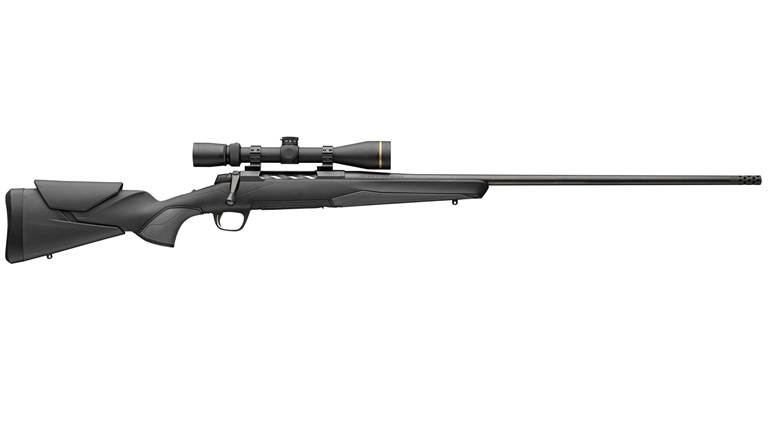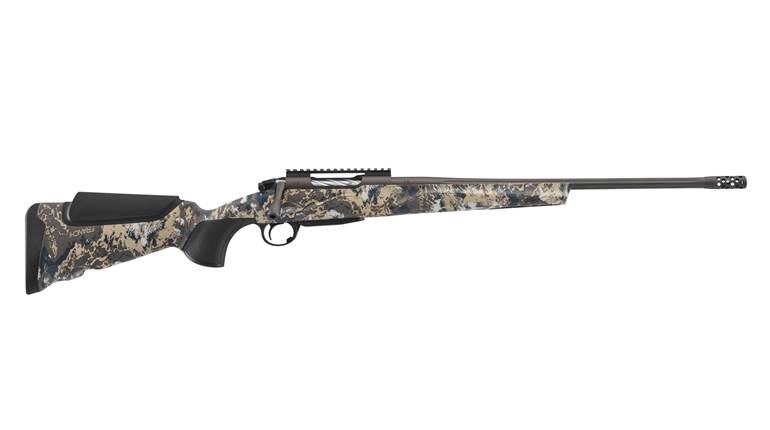
As part of the company that includes the successful Bergara franchise, CVA entered long-range muzzleloading holding a wildcard that allows it to match or exceed custom performance with a production rifle. To an even greater extent than with cartridge guns, barrels are the key to frontloader accuracy, and ever since their introduction in 2007, Bergara’s button-rifled, finely honed barrels have been in high demand across the gunmaking spectrum.
Since the Paramount’s 2018 debut, CVA has added a handful of variants, including the flagship Paramount Pro. It promises “higher velocities to make killing shots at 300 yards and beyond,” stemming from its ability to handle “super-magnum propellant charges.” To that end, the company singularly recommends Blackhorn 209 propellant in volumetric charges ranging from 140 to 170 grains.
While magnum loadings and long-range aspirations aren’t new, CVA doubled-down with faster rifling twists for the Paramounts—1:20" or 1:22", depending on caliber. Meanwhile, sister firm PowerBelt engineered new bullets to take advantage, and the resulting .45-cal. 285-grain PowerBelt ELR boasts a 0.333 ballistic coefficient (BC)—among the highest ever developed for blackpowder shooting.
To goose downrange performance even further, the Paramounts contain VariFlame breechplugs that use Large Rifle primers rather than the standby 209s. These rifles are heavy, though at 8 lbs., 12 ozs., the Pro is nearly a pound lighter than the original Paramount and the newer HTR model, and besides the fact that heavier rifles tend to shoot better, the extra heft is a blessing, given the recoil generated by robust powder charges. In short, the Paramount Pros are purpose-designed as long-range specialists.

Compared to its predecessors, the Pro’s Grayboe hand-painted fiberglass stock makes it look like a bona fide hunting rifle. And with lightweight aluminum pillar bedding to optimize balance, it handles like one, too, but nonetheless provides the rigid platform needed for long-range duty. While the fore-end lacks a ride-along ramrod, a folding, shock-corded rod in a belt pouch is supplied for field use, and it does have a handy hinged floorplate for holding extra primers.
A brown Cerakote finish over the nitride-treated stainless-steel metalwork complements the look and is as durable as any treatment we know about. Another premium is a TriggerTech trigger, hailed by precision-rifle competitors for consistent, clean breaks. The series boasts free-floating barrels, tang safeties, muzzle threading, a slew of tools and accessories (including both a range rod and a shock-corded field ramrod) and a funnel with a spout long enough to reach through muzzle brakes. Noteworthy, too, is the rifle’s lifetime warranty. With a suggested price of $1,668, it’s remarkable how far CVA has come from its roots in DIY kit guns.
For testing, we obtained a Paramount Pro .45-cal. with a 26" barrel and 1:22"-twist rifling. Also offered is the .50-cal. Colorado edition, factory-equipped with Williams peep sights to comply with that state’s hunting regulations. Before shooting can begin, Paramount Pros require hands-on effort to prime the metal VariFlame inserts, and tools are provided. Expect a learning curve here, and exercise due caution as you tap the primers into their pockets. We experienced one unwanted discharge, but having followed the cautionary “ears and eyes” directions, it was merely startling.

Also supplied with the rifles are clear plastic tubes marked in 10-grain volumetric increments up to 150 grains. These proved to be useful when pre-loaded before hunting and range sessions. A well-stocked cleaning kit comes in the box, and though the slick Bergara bore swabbed out easily, no blackpowder or substitute is residue-free.
Curious to see the Pro at long-range, we started with CVA’s suggested loading, but also tested reduced loads. Accuracy results were surprisingly uniform from one to the next, with all but one of 15 five-shot, 100-yard groups printing between 1" and 13/4". Most helpful at the bench was the consistent, clean break delivered by the rifle’s TriggerTech trigger.
In some metrics, the Pro stands toe-to-toe with centerfire performance. For example, CVA’s 2022 catalog shows the .45-cal. model firing the recommended max load attaining 2,560 f.p.s. at the muzzle, akin to .308 Win. velocities. Even so, the drop we observed at 300 yards from a 100-yard zero was 20", roughly twice that of the .308. More beneficial are its higher energy levels, with the aerodynamic 285-grain ELR slug generating 4,147 ft.-lbs. at the muzzle and retaining 1,346 ft.-lbs. at 500 yards, for a knockdown punch superior to all but the mightiest of .308 loads.
After initially getting accustomed to the .45’s recoil with stout charges, we were able to obtain a CVA muzzle brake expressly created to mate with the Paramount and sold as an add-on. The kick we felt minus the brake—noticeable though not punishing—was effectively tamed by it.
As muzzleloaders in this rarefied class gain a following among western hunters, CVA’s timing couldn’t have been better. Corporate bankruptcy eliminated the most obvious former competitor, the Remington Ultimate Muzzleloader, thereby leaving a field of custom-built rifles, each with its own roster of major components and features. Those we’ve seen are impressively capable, for which price tags start well into the $2,000s. One class-wide caveat is their bulk. While lugging around a ponderous rifle is practically a rite of passage for long-range practitioners, there’s a Sisyphean echo for hunters climbing beyond the timberline.
The Paramount Pro and its stablemates are now poised to dominate this select, high-performance segment and have, in fact, already clicked with both match shooters and hunters determined to blast old muzzleloader myths and limitations. 






































